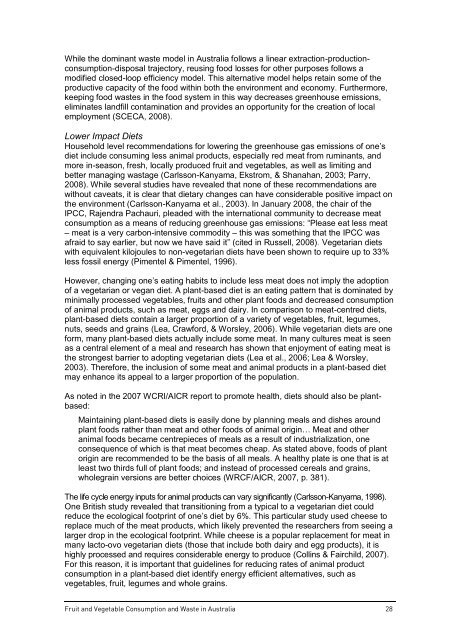Fruit and vegetable consumption and waste in Australia - VicHealth
Fruit and vegetable consumption and waste in Australia - VicHealth
Fruit and vegetable consumption and waste in Australia - VicHealth
Create successful ePaper yourself
Turn your PDF publications into a flip-book with our unique Google optimized e-Paper software.
While the dom<strong>in</strong>ant <strong>waste</strong> model <strong>in</strong> <strong>Australia</strong> follows a l<strong>in</strong>ear extraction-production<strong>consumption</strong>-disposal<br />
trajectory, reus<strong>in</strong>g food losses for other purposes follows a<br />
modified closed-loop efficiency model. This alternative model helps reta<strong>in</strong> some of the<br />
productive capacity of the food with<strong>in</strong> both the environment <strong>and</strong> economy. Furthermore,<br />
keep<strong>in</strong>g food <strong>waste</strong>s <strong>in</strong> the food system <strong>in</strong> this way decreases greenhouse emissions,<br />
elim<strong>in</strong>ates l<strong>and</strong>fill contam<strong>in</strong>ation <strong>and</strong> provides an opportunity for the creation of local<br />
employment (SCECA, 2008).<br />
Lower Impact Diets<br />
Household level recommendations for lower<strong>in</strong>g the greenhouse gas emissions of one’s<br />
diet <strong>in</strong>clude consum<strong>in</strong>g less animal products, especially red meat from rum<strong>in</strong>ants, <strong>and</strong><br />
more <strong>in</strong>-season, fresh, locally produced fruit <strong>and</strong> <strong>vegetable</strong>s, as well as limit<strong>in</strong>g <strong>and</strong><br />
better manag<strong>in</strong>g wastage (Carlsson-Kanyama, Ekstrom, & Shanahan, 2003; Parry,<br />
2008). While several studies have revealed that none of these recommendations are<br />
without caveats, it is clear that dietary changes can have considerable positive impact on<br />
the environment (Carlsson-Kanyama et al., 2003). In January 2008, the chair of the<br />
IPCC, Rajendra Pachauri, pleaded with the <strong>in</strong>ternational community to decrease meat<br />
<strong>consumption</strong> as a means of reduc<strong>in</strong>g greenhouse gas emissions: “Please eat less meat<br />
– meat is a very carbon-<strong>in</strong>tensive commodity – this was someth<strong>in</strong>g that the IPCC was<br />
afraid to say earlier, but now we have said it” (cited <strong>in</strong> Russell, 2008). Vegetarian diets<br />
with equivalent kilojoules to non-vegetarian diets have been shown to require up to 33%<br />
less fossil energy (Pimentel & Pimentel, 1996).<br />
However, chang<strong>in</strong>g one’s eat<strong>in</strong>g habits to <strong>in</strong>clude less meat does not imply the adoption<br />
of a vegetarian or vegan diet. A plant-based diet is an eat<strong>in</strong>g pattern that is dom<strong>in</strong>ated by<br />
m<strong>in</strong>imally processed <strong>vegetable</strong>s, fruits <strong>and</strong> other plant foods <strong>and</strong> decreased <strong>consumption</strong><br />
of animal products, such as meat, eggs <strong>and</strong> dairy. In comparison to meat-centred diets,<br />
plant-based diets conta<strong>in</strong> a larger proportion of a variety of <strong>vegetable</strong>s, fruit, legumes,<br />
nuts, seeds <strong>and</strong> gra<strong>in</strong>s (Lea, Crawford, & Worsley, 2006). While vegetarian diets are one<br />
form, many plant-based diets actually <strong>in</strong>clude some meat. In many cultures meat is seen<br />
as a central element of a meal <strong>and</strong> research has shown that enjoyment of eat<strong>in</strong>g meat is<br />
the strongest barrier to adopt<strong>in</strong>g vegetarian diets (Lea et al., 2006; Lea & Worsley,<br />
2003). Therefore, the <strong>in</strong>clusion of some meat <strong>and</strong> animal products <strong>in</strong> a plant-based diet<br />
may enhance its appeal to a larger proportion of the population.<br />
As noted <strong>in</strong> the 2007 WCRI/AICR report to promote health, diets should also be plantbased:<br />
Ma<strong>in</strong>ta<strong>in</strong><strong>in</strong>g plant-based diets is easily done by plann<strong>in</strong>g meals <strong>and</strong> dishes around<br />
plant foods rather than meat <strong>and</strong> other foods of animal orig<strong>in</strong>… Meat <strong>and</strong> other<br />
animal foods became centrepieces of meals as a result of <strong>in</strong>dustrialization, one<br />
consequence of which is that meat becomes cheap. As stated above, foods of plant<br />
orig<strong>in</strong> are recommended to be the basis of all meals. A healthy plate is one that is at<br />
least two thirds full of plant foods; <strong>and</strong> <strong>in</strong>stead of processed cereals <strong>and</strong> gra<strong>in</strong>s,<br />
wholegra<strong>in</strong> versions are better choices (WRCF/AICR, 2007, p. 381).<br />
The life cycle energy <strong>in</strong>puts for animal products can vary significantly (Carlsson-Kanyama, 1998).<br />
One British study revealed that transition<strong>in</strong>g from a typical to a vegetarian diet could<br />
reduce the ecological footpr<strong>in</strong>t of one’s diet by 6%. This particular study used cheese to<br />
replace much of the meat products, which likely prevented the researchers from see<strong>in</strong>g a<br />
larger drop <strong>in</strong> the ecological footpr<strong>in</strong>t. While cheese is a popular replacement for meat <strong>in</strong><br />
many lacto-ovo vegetarian diets (those that <strong>in</strong>clude both dairy <strong>and</strong> egg products), it is<br />
highly processed <strong>and</strong> requires considerable energy to produce (Coll<strong>in</strong>s & Fairchild, 2007).<br />
For this reason, it is important that guidel<strong>in</strong>es for reduc<strong>in</strong>g rates of animal product<br />
<strong>consumption</strong> <strong>in</strong> a plant-based diet identify energy efficient alternatives, such as<br />
<strong>vegetable</strong>s, fruit, legumes <strong>and</strong> whole gra<strong>in</strong>s.<br />
<strong>Fruit</strong> <strong>and</strong> Vegetable Consumption <strong>and</strong> Waste <strong>in</strong> <strong>Australia</strong> 28


